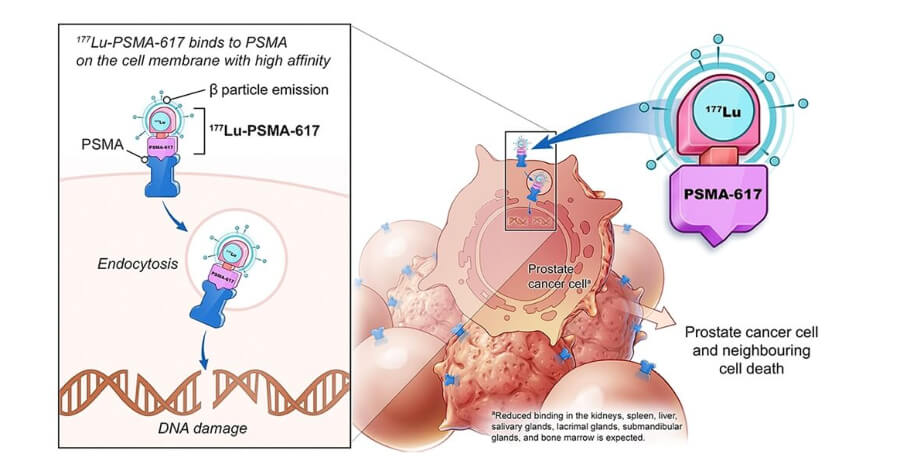The news of a cancer diagnosis can feel like a punch to the gut, leaving you scrambling for information and desperately seeking hope. Enter lutetium 177 (Lu-177), a radioactive superhero emerging on the cancer treatment scene. But before you picture yourself in a radioactive suit, let’s break down what Lu-177 is and how it might improve your odds of winning the battle against cancer.
Why Choose Lu-177?
Unlike conventional chemo which throws a grenade at everything in your body, Lu-177 is a smarter, sniper kind of therapy. It attaches to specific molecules on cancer cells, called receptors, like a key fitting into a lock. This targeted approach minimizes collateral damage to healthy tissues, meaning fewer side effects and better quality of life during treatment.
Types of Lu-177 Therapy
Lu-177 plays its starring role in several types of therapy, but the two main players are:
Radioligand Therapy: Think of it as a Trojan Horse. Lu-177 hitches a ride on a molecule that binds to cancer cell receptors, delivering a lethal dose of radiation directly to the enemy. This type is particularly effective for prostate, neuroendocrine, and some types of breast cancer.
Targeted Radionuclide Therapy: Lu-177, like a miniature radioactive bomb, goes directly to the tumor site, emitting radiation to fry cancer cells from within. This type is used for treating various cancers, including liver, bone, and ovarian.
Benefits of Lu-177 Therapy
Improved Survival Rates: Studies show that Lu-177 can significantly extend lifespan and delay tumor progression. For example, in prostate cancer, Lu-177 therapy combined with standard treatment has been shown to improve overall survival by months, even years.
Fewer Side Effects: Because Lu-177 targets cancer cells specifically, it spares healthy tissues, leading to less nausea, fatigue, and hair loss. This translates to a better quality of life during treatment.
Outpatient Treatment: In most cases, Lu-177 therapy is done on an outpatient basis, meaning you can get your dose and head home without long hospital stays.
Steps Involved
Diagnosis and Confirmation: First, your doctor will confirm your diagnosis and assess if you’re a good candidate for lutetium therapy. Tests like PSMA scans for prostate cancer might be needed.
Preparation: This may involve pre-medications and hydration to protect healthy tissues from radiation.
Administration: Depending on the type of Lu-177 therapy, you may receive the medication through an IV drip, injection, or targeted delivery directly to the tumor. The process itself is usually quick and painless.
Monitoring: After treatment, your doctor will closely monitor your progress and side effects, offering additional support as needed.
Conclusion
Lu-177 therapy is not a magical cure-all, but it’s a powerful tool in the fight against cancer, offering hope for longer life and better quality of life. While research is ongoing, the current evidence suggests that Lu-177 can be a valuable addition to the cancer treatment arsenal.
FAQs
Is Lu-177 covered by insurance?
Depending on your insurance plan and specific condition, coverage may vary. It’s best to discuss this with your doctor and insurance provider.
What are the side effects?
Fatigue, nausea, dry mouth, and temporary changes in blood cell counts are some common side effects. These are usually manageable with medication and support.
Where can I get Lu-177 therapy?
Talk to your oncologist to find out if a treatment center near you offers Lu-177 therapy. Remember, this therapy is still evolving, so it might not be available everywhere yet.
We hope this information empowers you to have informed conversations with your doctor about Lu-177 therapy and make the best decisions for your health. Remember, even in the face of cancer, there are always reasons to hope. And who knows, Lu-177 might just be the shining beacon you need to guide you towards a brighter future.
How many doses of Lu-177 treatment are typically needed?
The number of doses varies depending on the type and stage of your cancer, your overall health, and response to treatment. Typically, several cycles of therapy are administered, spaced a few weeks apart. Your doctor will personalize your treatment plan based on your unique needs.
Are there any risks associated with Lu-177 therapy?
As with any medical procedure, some risks are associated with Lu-177 therapy. The most common side effects include fatigue, nausea, vomiting, mouth sores, and temporary changes in blood cell counts. In rare cases, more serious side effects like kidney or liver problems can occur. Discuss these risks thoroughly with your doctor to understand if they are manageable for you.
Does Lu-177 therapy interfere with other medications I’m taking?
It’s crucial to tell your doctor about all medications and supplements you take, including over-the-counter drugs. Lu-177 can interact with certain medications, affecting their effectiveness or increasing side effects. Your doctor will adjust your medication regimen or advise you on potential interactions before starting Lu-177 therapy.
Can Lu-177 therapy be combined with other cancer treatments?
Yes, Lu-177 is often used alongside other cancer treatments like chemotherapy, radiation therapy, and surgery. The combination can be highly effective, depending on your specific situation. Your doctor will determine the best treatment plan for you, considering your overall health and cancer type.
What happens after Lu-177 therapy?
Following your treatment, your doctor will closely monitor your progress with regular checkups and blood tests. This is to track your response to treatment, manage any side effects, and detect any potential recurrences. Depending on your progress, further Lu-177 cycles or other treatment options might be recommended.
Is there ongoing research on Lu-177 therapy?
Yes, research on Lu-177 therapy is ongoing, exploring its effectiveness in treating various cancers and improving its delivery methods. Additionally, scientists are investigating new Lu-177-based radioligands targeting different cancer cell receptors. This continuous research holds promise for expanding the reach and effectiveness of Lu-177 therapy in the future.

